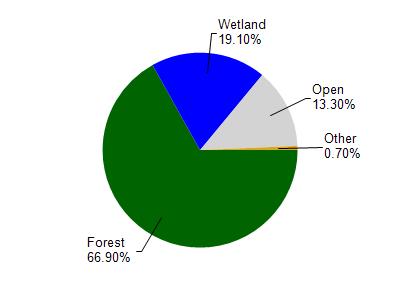Vilas
No
No
No
Fish and Aquatic Life
Overview
A portion of the Manitowish River in Vilas County is designated an exceptional resource water under the state antidegradation policy. This portion includes the river from the Rest Lake dam in Vilas County downstream to the river's confluence with Bear River in Iron County. The river's flow is captured by Rest Lake dam, which was constructed in 1887 for water storage. It has been operated by the Chippewa Flambeau Improvement Corporation since 191 1. Rest Lake is drawn down in winter and is restored in spring.
Larson, Nancy and Lisa Kosmond (Helmuth). 1996. Upper Chippewa River Basin Water Quality Management Plan.
PUBL-WR-345-96-REV. Wisconsin Department of Natural Resources, Madison, WI.
Date 1996
Author Aquatic Biologist
Overview
The Manitowish River supports a warm water sport fishery. It was approved by the Natural Resources Board in January 1993 to be classified as Exceptional Resource Water under NR 102. Index of Biotic Integrity sampling conducted in 199 1 indicated excellent water quality. Two threatened species of fish were recorded during the survey. These observations included both adult and young-of-year pugnose shiner and greater redhorse. The lake sturgeon population in the river is badly depleted. A real danger exists of loosing this valuable fishery if steps are not taken to identify the causes of declining reproduction and recruitment. There is speculation that rusty crayflsh may be having an impact on egg survival, but we have no documentation for this. An area along the Manitowish River near Benson Lake is known to be experiencing erosion. A Sturgeon Project Area has been established between Rest Lake Dam and Benson Lake, and a study has been proposed to assess habitat, environmental conditions, and to collect data on sturgeon and other fish species. The study's objective is to gather the necessary data to develop a plan to rehabilitate the sturgeon population. This project also has implications to the treaty fishery, and for Federal Energy Regulatory Commission (FERC) re-licensing relative to operation of the Rest Lake Dam.
Date 1996
Author Aquatic Biologist
Condition
Wisconsin has over 84,000 miles of streams, 15,000 lakes and milllions of acres of wetlands. Assessing the condition of this vast amount of water is challenging. The state's water monitoring program uses a media-based, cross-program approach to analyze water condition. An updated monitoring strategy (2015-2020) is now available. Compliance with Clean Water Act fishable, swimmable standards are located in the Executive Summary of Water Condition in 2018. See also the 'monitoring and projects' tab.
Reports
Management Goals
Wisconsin's Water Quality Standards provide qualitative and quantitative goals for waters that are protective of Fishable, Swimmable conditions [Learn more]. Waters that do not meet water quality standards are considered impaired and restoration actions are planned and carried out until the water is once again fishable and swimmable
Management goals can include creation or implementation of a Total Maximum Daily Load analysis, a Nine Key Element Plan, or other restoration work, education and outreach and more. If specific recommendations exist for this water, they will be displayed below online.
Monitoring
Monitoring the condition of a river, stream, or lake includes gathering physical, chemical, biological, and habitat data. Comprehensive studies often gather all these parameters in great detail, while lighter assessment events will involve sampling physical, chemical and biological data such as macroinvertebrates. Aquatic macroinvertebrates and fish communities integrate watershed or catchment condition, providing great insight into overall ecosystem health. Chemical and habitat parameters tell researchers more about human induced problems including contaminated runoff, point source dischargers, or habitat issues that foster or limit the potential of aquatic communities to thrive in a given area. Wisconsin's Water Monitoring Strategy was recenty updated.
Grants and Management Projects
Monitoring Projects
| WBIC | Official Waterbody Name | Station ID | Station Name | Earliest Fieldwork Date | Latest Fieldwork Date | View Station | View Data |
|---|
| 2324400 | Manitowish River | 10034224 | Rest Lake - Stone Lake Channel | 6/12/2015 | 9/12/2024 | Map | Data |
| 2324400 | Manitowish River | 10031658 | Manitowish River -on Oak St deepest spot betw. Rest & Stone lakes | 8/18/2010 | 9/16/2019 | Map | Data |
|

Watershed Characteristics
Manitowish River is located in the Manitowish River watershed which is 268.60 mi². Land use in the watershed is primarily forest (66.90%), wetland (19.10%) and a mix of open (13.30%) and other uses (0.70%). This watershed has 212.08 stream miles, 22,943.16 lake acres and 33,727.48 wetland acres.
Nonpoint Source Characteristics
This watershed is ranked Low for runoff impacts on streams, Low for runoff impacts on lakes and Low for runoff impacts on groundwater and therefore has an overall rank of Low. This value can be used in ranking the watershed or individual waterbodies for grant funding under state and county programs.However, all waters are affected by diffuse pollutant sources regardless of initial water quality. Applications for specific runoff projects under state or county grant programs may be pursued. For more information, go to surface water program grants.